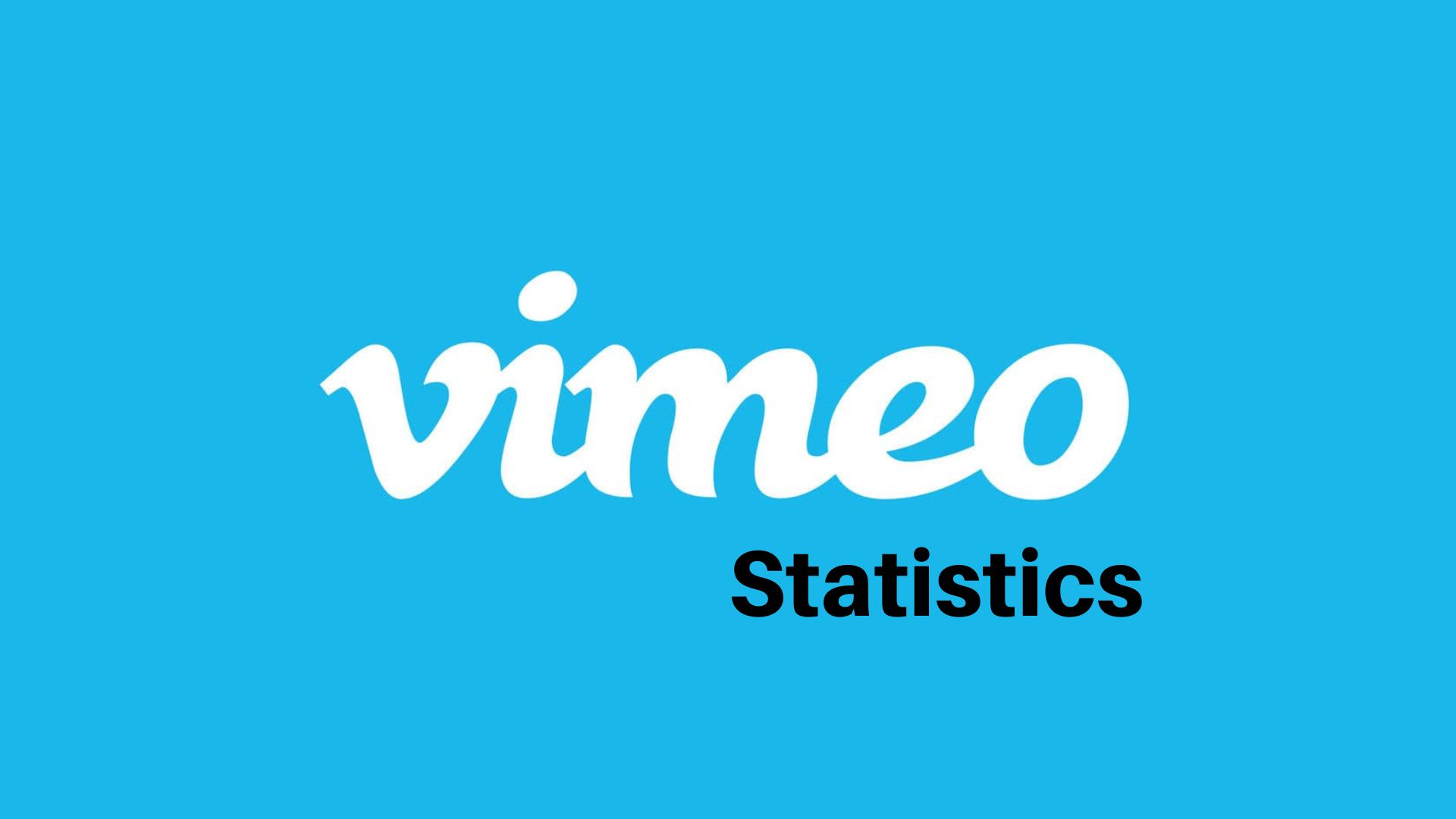OpenAI Statistics 2024 By Demographics, Products, Revenue and Growth
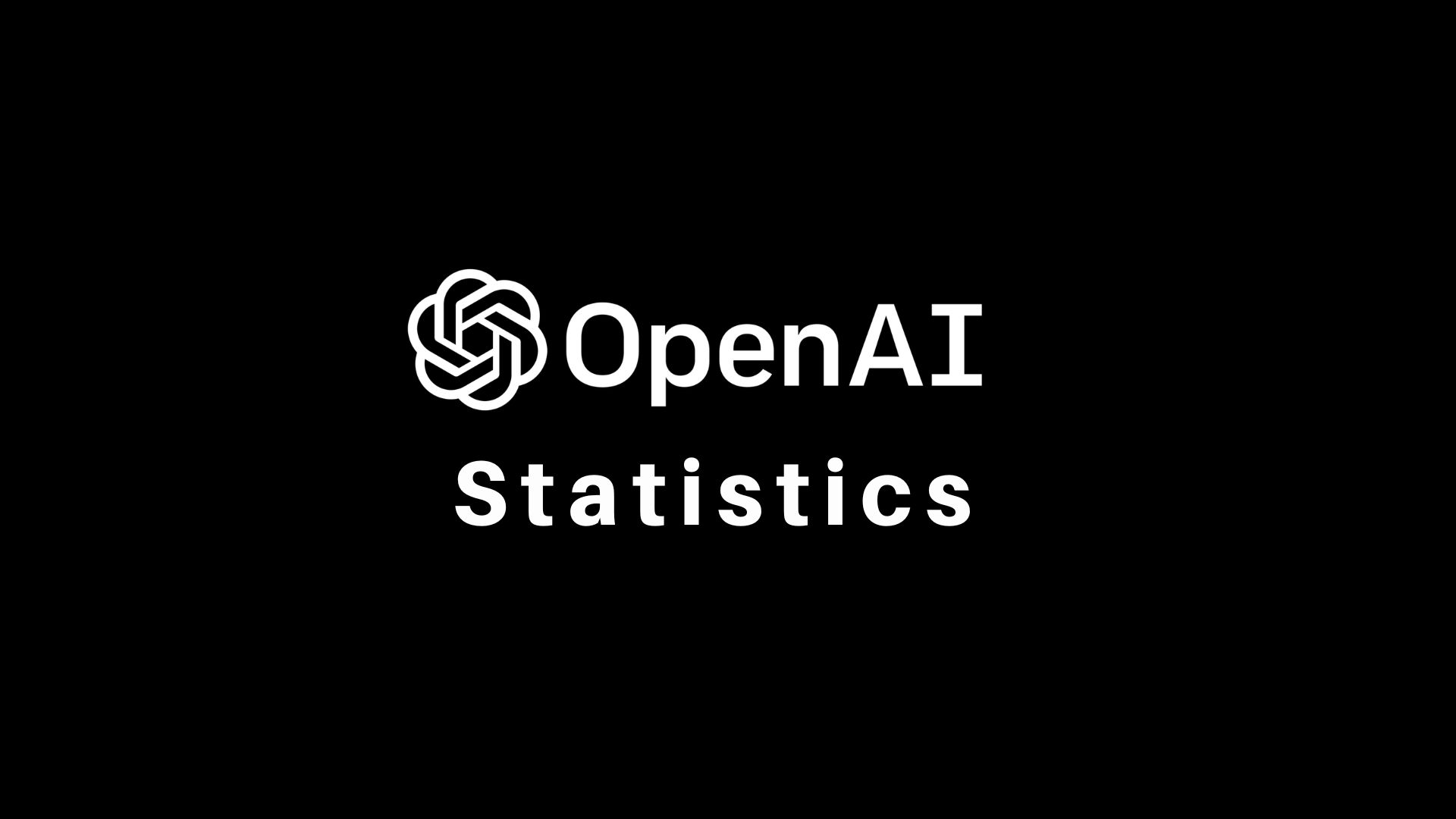
Page Contents [hide]
Introduction
OpenAI statistics: OpenAI, established as a leading entity in artificial intelligence, has showcased remarkable growth and impact across various sectors. In 2023, OpenAI's revenue saw an astonishing 700% increase, underscoring its ambitious expansion and the high value placed on its AI capabilities. This surge in revenue is part of a broader strategy to cement OpenAI's position as one of the most valued startups in the United States, with efforts to pursue new funding targeting a $100 billion valuation. The company has faced and overcome significant challenges, including leadership disputes and legal hurdles, while also navigating the competitive landscape of generative AI.
OpenAI's offerings, including the renowned GPT-3 and DALL-E models, have garnered widespread usage and attention. GPT-3, an advanced autoregressive transformer language model, and DALL-E, a model capable of generating digital images from textual descriptions, stand as testaments to OpenAI's innovation in AI research and development. As of late 2023, OpenAI's website traffic and the monthly active user count reflect its growing influence, with a notable presence in over 156 countries and a valuation that underscores its significant market position.
The AI market, projected to reach $407 billion by 2027, has seen an accelerated adoption of AI technologies, with OpenAI at the forefront of this transformation. Estimates suggest that 80% of jobs can incorporate AI, highlighting the potential for generative AI to revolutionize work life across diverse roles, from data entry clerks to market research analysts.
Demographically, OpenAI's user base is diverse, with a gender distribution of 56.11% male and 43.89% female users. The majority of its users fall within the 25-34 age group, indicating its appeal among younger, tech-savvy demographics. The United States leads in traffic to OpenAI's platform, followed by India, Colombia, the Philippines, and Japan, illustrating its global reach and the widespread interest in AI technologies.
Editor’s Choice
- OpenAI has garnered a user base of 180.5 million, with 1.6 billion visits recorded in December 2023, and attracts 100 million weekly users according to CEO Sam Altman.
- Over 3,000,000 active developers are utilizing DALL-E for training algorithms.
- The OpenAI platform, operational in 156 countries, enables creation of recipes from given ingredients.
- Microsoft's investment in OpenAI reached USD 10 billion in 2023, with expected funding to rise to USD 11.3 billion by year-end.
- User demographics on openai.com show 69.59% male and 30.41% female users.
- The generative AI market is predicted to grow at a CAGR of 31.4% from 2023 to 2032.
- In the Hurun Global Unicorn Index 2023, OpenAI secured the 17th position out of 100.
- Direct traffic constitutes 85.65% of the total traffic to openai.com.
- Larger companies, particularly those with over 10,000 employees, are the primary users of OpenAI technologies.
- Openai.com boasts 99.99% organic traffic, with a mere 0.01% coming from paid sources.
- Daily operational costs of OpenAI worldwide are around USD 700,000.
- The technology sector leads in adopting OpenAI services.
- ChatGPT reached 100 million users within two months of its launch, illustrating its rapid adoption.
- OpenAI is unavailable in 40 countries, including China, Russia, Ukraine, and Iran.
- Expected to become the most valuable in the AI sector, OpenAI's revenue is forecasted to exceed USD 200 million by the end of 2023 and surpass USD 1 billion in 2024.
- Approximately 70% of ChatGPT's social media traffic is sourced from YouTube.
- Nearly 15% of ChatGPT's user base is American.
- Founded in 2015 by notable figures including Elon Musk and Sam Altman, OpenAI prioritizes AI's safety and humanity's benefit.
- The organization has received over USD 12 billion in investments, with significant contributions from Microsoft and Amazon Web Services.
- The launch of ChatGPT 3.5 in late 2022 brought OpenAI into the public eye, demonstrating the company's innovative capabilities in AI and machine learning.
You May Also Like To Read
- ChatGPT-4 Statistics
- Google Bard Statistics
- ChatGPT Statistics
- GitHub Statistics
- Google Play Store Statistics
- Twitch Statistics
- Oracle Statistics
- Node JS Statistics
- UX Statistics
- Virtual Reality Statistics
- Augmented Reality Statistics
About OpenAI
OpenAI is a pioneering artificial intelligence research lab, founded in 2015 by a group of entrepreneurs and researchers including Elon Musk and Sam Altman. Its primary mission is to ensure that artificial general intelligence (AGI)—machines capable of understanding, learning, and reasoning at a human level—benefits all of humanity. OpenAI distinguishes itself through its commitment to open collaboration and the ethical development of AI technologies, aiming to guide the progress of AI in ways that mitigate risks and maximize societal benefits. The organization operates as both a research institute and a development hub, producing advanced AI models like GPT (Generative Pre-trained Transformer) and DALL-E, which have significantly influenced the field of machine learning and natural language processing.
Over the years, OpenAI has transitioned from a non-profit entity to a capped-profit model, allowing it to attract capital while maintaining its ethos of broad-based benefit. It has been at the forefront of addressing critical issues surrounding AI, such as safety, transparency, and ethical use. OpenAI's work encompasses a wide range of AI applications, from natural language processing and computer vision to robotics and AI safety. The lab's most notable contributions include the development of ChatGPT, a conversational AI model, and DALL-E, an AI system capable of generating images from textual descriptions. These innovations not only showcase OpenAI's technical prowess but also its role in pushing the boundaries of what AI can achieve, thus shaping the future of technology and its integration into society.
OpenAI Features
OpenAI offers a suite of features and capabilities across its various AI models and platforms, demonstrating its leadership in the field of artificial intelligence. Here are some of the notable features:
- Generative Pre-trained Transformer (GPT) Models: OpenAI has developed several iterations of GPT, including GPT-3, the most advanced version, which is capable of understanding and generating human-like text based on the input it receives. This enables applications in conversational AI, content creation, and more.
- DALL-E: A groundbreaking AI capable of generating images from textual descriptions, DALL-E allows users to create detailed and specific visuals by simply describing what they want to see, opening new possibilities in digital art and design.
- Codex: This AI system is designed to understand and generate code, making it a powerful tool for developers. Codex can automate coding tasks, explain code in natural language, and even help with learning programming languages.
- ChatGPT: A variant of GPT-3 optimized for conversational responses, ChatGPT can engage in dialogue, answer questions, and provide explanations as if it were a human, making it useful for customer service, tutoring, and interactive applications.
- Whisper: An automatic speech recognition system designed to accurately transcribe speech into text, supporting multiple languages and dialects. Whisper facilitates the development of voice-activated applications and services.
- API Access: OpenAI provides API access to its models, allowing developers to integrate advanced AI capabilities into their own applications and services. This enables a wide range of custom implementations, from automated content generation to intelligent chatbots.
- Safety and Ethical AI Development: OpenAI is committed to the safe and ethical development of AI, implementing guidelines and research to mitigate risks associated with AI technologies. This includes efforts to ensure fairness, transparency, and security in AI applications.
- Continuous Learning and Improvement: OpenAI's models are designed to learn from interactions, continuously improving their accuracy, relevance, and performance over time. This ensures that applications powered by OpenAI remain at the cutting edge of AI capabilities.
- Multi-language Support: GPT-3 and other OpenAI models support multiple languages, making it possible to develop global applications that can communicate and interact with users in their native languages.
- Customizability: OpenAI offers tools and resources for training custom versions of its models, allowing organizations to tailor AI capabilities to their specific needs and challenges.
OpenAI Evolution
The evolution of OpenAI from its inception until December 2023 is marked by significant milestones, innovations, and leadership changes, shaping it into a leading force in the artificial intelligence (AI) landscape. Here's an overview of its journey:
- 2015: OpenAI was founded with ambitions to advance AI for humanity's benefit, backed by prominent figures and organizations pledging over $1 billion.
- 2016: Key releases included OpenAI Gym for reinforcement learning research, and the receipt of Nvidia's first DGX-1 supercomputer, enhancing AI model training capabilities.
- 2019: OpenAI transitioned from a non-profit to a “capped” for-profit entity, bolstered by a $1 billion investment from Microsoft. This year also saw the announcement of GPT-2.
- 2020: The debut of GPT-3, a landmark in AI language models, marked OpenAI's first commercial product with an API.
- 2021: Introduction of DALL-E, showcasing the ability to generate digital images from text descriptions.
- 2022: Launch of ChatGPT, a chatbot based on GPT-3.5, quickly gaining widespread attention.
- 2023: OpenAI introduced various innovations including ChatGPT Plus, the ChatGPT API, and the release of GPT-4, further expanding AI's reliability and applications. Significant updates and expansions were made, including launching ChatGPT for iOS and Android, making AI more accessible across platforms.
Throughout these years, OpenAI's focus on ethical AI deployment, groundbreaking AI models, and making AI advancements accessible has profoundly influenced the tech industry and beyond. Leadership changes, including the temporary removal and subsequent return of Sam Altman as CEO, underscored the dynamic nature of OpenAI's journey. The consistent aim to balance profit with the mission of benefiting humanity reflects OpenAI's commitment to responsible AI development.
Facts About OpenAI
- According to the reports, OpenAI systems are running on the fifth most powerful system in the globe.
- OpenAI allows for conducting research in different segments of AI such as robotics, natural language processing, machine language, reinforcement learning, and computer vision.
- Research papers created by OpenAI have been cited more than 16,800 times by academics.
- The platform has won many awards such as AAAI Classic Paper Award and Turing Award.
- Moreover, the platform has been released in more than 200 open-source projects as well as 800+ public research papers.
- OpenAI has starred in more than 10,000 press articles.
- New York City public schools initially banned ChatGPT, but reversed the ban months later in May 2023.
- In March 2023, GPT-4 technology and ChatGPT Plugins were added by OpenAI to provide effective support to ChatGPT Plus users.
- On the other hand, GPT-4 has beat 90% of human work for those who have the ability to become lawyers.
What is AI and Its Examples?
Artificial Intelligence (AI) refers to the simulation of human intelligence in machines that are programmed to think like humans and mimic their actions. The term can also apply to any machine that exhibits traits associated with a human mind such as learning and problem-solving. AI is broadly classified into four types:
- Reactive Machines: These AI systems do not have past memory and cannot use past information for future actions. They are designed to do a limited set of tasks. An example is IBM's Deep Blue, which beat Garry Kasparov in chess.
- Limited Memory: This type of AI can use past experiences to inform future decisions. Most current AI applications, from self-driving cars to chatbots like Siri and Alexa, fall under this category.
- Theory of Mind: This is an advanced class of AI that researchers are still developing. It refers to AI that can understand emotions, people, beliefs, and interact socially like humans.
- Self-aware AI: This is the future goal of AI research. These systems will be super intelligent, sentient, and self-aware, far beyond anything currently available.
Examples of AI in everyday use include virtual personal assistants such as Amazon's Alexa, Apple's Siri, Google's Assistant, and Microsoft's Cortana. These AI systems can perform tasks or services based on commands from the user. They help in finding information (using voice-to-text technology), sending commands to other apps (like playing music or setting alarms), and automating responses to simple queries.
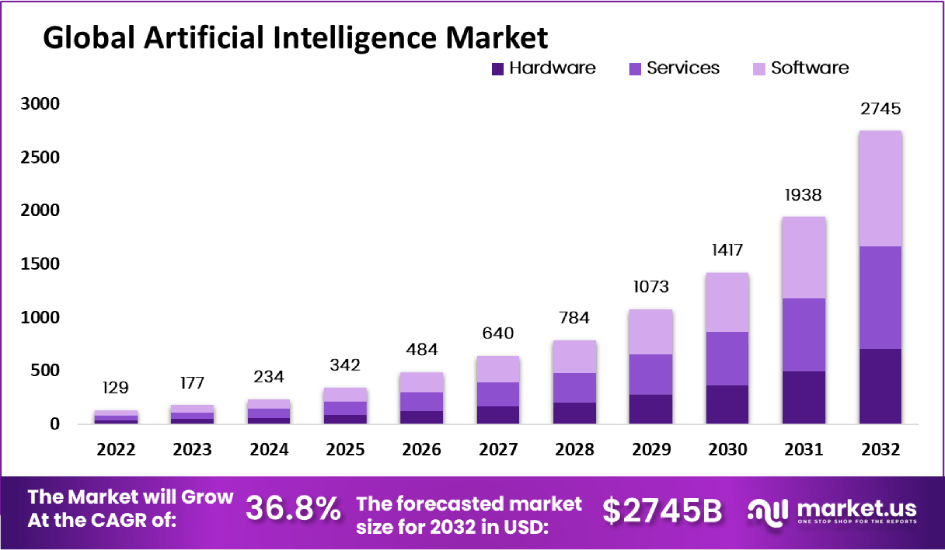
The AI industry is rapidly growing, with the global artificial intelligence market projected to increase significantly in value. It is estimated that the market size will reach around USD 2,745 billion by 2033, up from USD 177 billion in 2023, growing at a compound annual growth rate (CAGR) of 36.8% during the forecast period from 2024 to 2033. This growth underscores the increasing integration of AI technologies across various sectors, from healthcare and automotive to finance and entertainment, reflecting AI's critical role in driving future innovations and efficiencies.
OpenAI Products
- OpenAI Five: OpenAI Five is a computer program that can play a five-on-five video game Dota 2. It was initially launched in the year 2017. The algorithms of Dota 2 have been taken by another neural network. Open AI five in comparison with AI has been tested with a physical robotic hand to play computer vs. human games such as video games; StarCraft II, AlphaGo, and Board games; Go, Deep Blue.
- By using 159 GB of Python code and 54 million repositories of GitHub, OpenAI Codex was trained.
- More than 12 programming languages were used for the functioning of OpenAI Codex which was claimed by OpenAI.
OpenAI has developed a range of products that leverage artificial intelligence for various purposes, from enhancing creativity to solving complex problems. Here's a list of some notable OpenAI products:
- GPT-4: The latest iteration of the Generative Pre-trained Transformer models, known for generating human-like text and capable of handling over 25,000 words of text for applications like content creation and document analysis.
- DALL·E: An AI system that creates realistic images and art from textual descriptions, capable of original creations, making edits, and generating variations of images.
- OpenAI Gym: A toolkit for developing and comparing reinforcement learning algorithms, widely used in both research and industry for training AI agents.
- OpenAI RoboSumo: A simulated environment within the OpenAI Gym toolkit for developing and testing robotic control algorithms through a sumo-wrestling match between two robots.
- OpenAI Debate Game: A tool that uses AI to simulate debates by generating text representing arguments and counterarguments on selected topics.
- OpenAI Dactyl: A robotic hand designed to learn and adapt to new tasks using machine learning, capable of manipulating objects and solving puzzles like Rubik’s Cube.
- Generative Models including DALL-E and ChatGPT: Systems trained to generate new, original content based on patterns learned from data. These models have applications in language translation, image generation, music composition, and more.
These products underscore OpenAI's commitment to advancing AI technology and its applications across various fields. From creating art from text descriptions to simulating debates and developing robotic control algorithms, OpenAI's product suite represents the cutting edge of artificial intelligence research and application.
General OpenAI Statistics
- Rapid User Growth: ChatGPT set a record by becoming the fastest platform to reach 1 million users in just five days after launch, eventually reaching 100 million users in two months.
- Diverse Product Suite: Beyond ChatGPT, OpenAI offers DALL-E 2 for image generation and Whisper for language transcription and translation, among other notable products.
- Widespread Adoption: Globally renowned companies like Microsoft, Duolingo, and Stripe are integrating OpenAI's products into their services.
- Significant Revenue Growth: OpenAI's revenue is estimated to rise from around $200 million in 2023 to $1 billion in 2024.
- High Employee Compensation: Engineers at OpenAI reportedly earn around $925,000/year, highlighting the competitive compensation within the company.
- Microsoft's Investment: Microsoft invested a significant $10 billion in OpenAI in early 2023, holding a reported 49% stake in the company.
- Valuation: OpenAI's valuation is estimated between $27-29 billion, making it one of the world's most valuable private companies.
- Website Traffic: Openai.com records approximately 1.7 billion monthly visits, ranking it as the 20th most visited website globally as of June 2023.
- Social Media Influence: YouTube is the largest source of social media traffic to OpenAI, reflecting the platform's significant online presence.
- Demographic Insights: OpenAI's user base is predominantly young, with over one-third of users aged between 25 and 34 years.
- Business Utilization: OpenAI is used by companies across the United States, with California leading in adoption.
- Industry Application: Over 250 technology companies, followed by 209 educational institutions, are utilizing OpenAI, showcasing its broad industry appeal.
- Global Presence: OpenAI is accessible in 156 countries, with the top five user countries being the US, India, France, Spain, and the UK.
By States
- As per OpenAI statistics; as of today, there are many companies that are accommodating to OpenAI with their business processes. The following are the number of companies using OpenAI in the United States of America.
- Texas has around 27 companies accommodating OpenAI. Similarly, Florida has 16 companies overall.
- Other states have Missouri (5), Georgia (06), South Carolina (4), Illinois (22), California (167), Texas (27), Virginia (20), and New York (54).
- California’s 167 companies have already started to accommodate OpenAI
- Furthermore, states are Texas with 27 companies for accommodating OpenAI. Similarly, New York has 54 companies overall.
- Other states with a number of companies that use OpenAI in their processes are followed by Illinois (22), Virginia (20), Georgia (06), and South Carolina (4).
By Industry
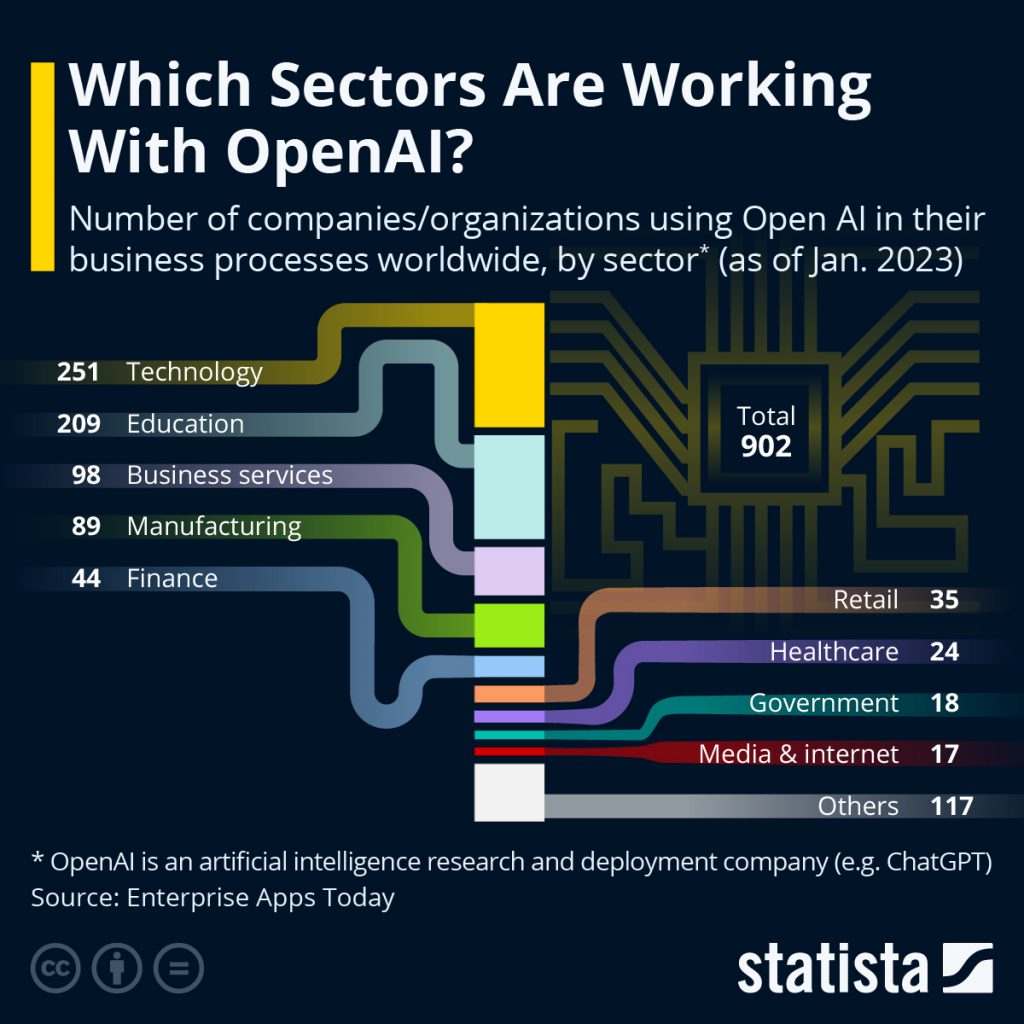
(Source: statcdn.com)
- There are multiple types of sectors that use OpenAI in their business processes. As per the above chart, OpenAI statistics showed that the technology sector has the highest number of companies supporting the platform.
- Whereas is obvious, that the education sector has 209 institutions that have OpenAI.
- As of 2023, the topmost industry that is supporting the OpenAI platform is the Technology sector which includes around 251 companies.
- Furthermore, other number of companies that are currently using the OpenAI platform are followed by the Educational sector (209), Business Services Sector (98), Manufacturing sector (89), Finance sector (44), Retail sector (35), Healthcare sector (24), Healthcare (24), Government (18), Media and Internet (17) and others (117).
By Employees
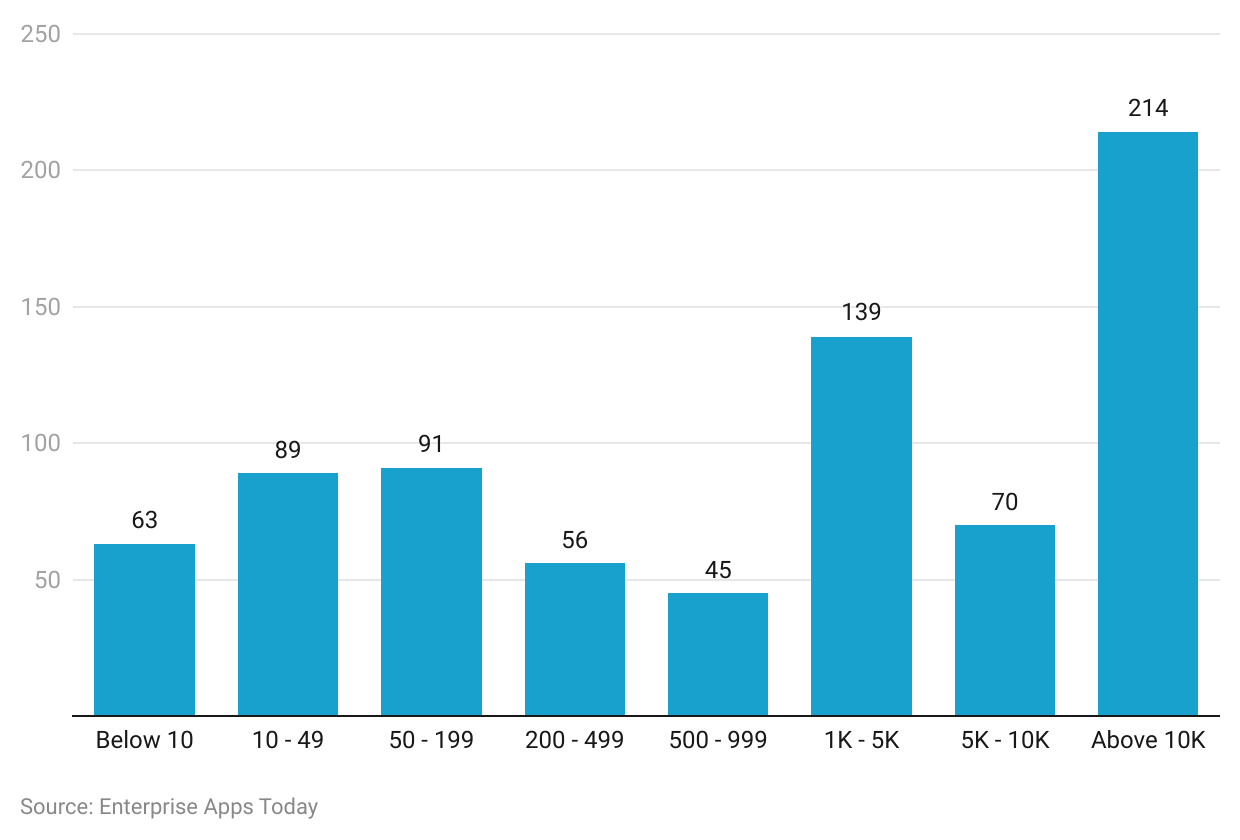
(source: HG Insights)
- Around the globe, there are 63 companies using OpenAI whose employee count is below 10.
- According to OpenAI statistics; Companies with 10 to 49 headcounts are around 89 in total.
- Companies around the world that have 50 to 199 employees are around 91 using the platform.
- Similarly, companies with a head count of 200 to 499 are around 56 supporting the platform.
- There is the following number of companies with respective employee counts using OpenAI. 500 to 999 (45), 1000 to 5000 (139), 5,000 to 10,000 (70), and 10,000 and above (214).
- The highest number of companies using OpenAI belongs to companies with an employee count of 10,000 and above.
By Revenue
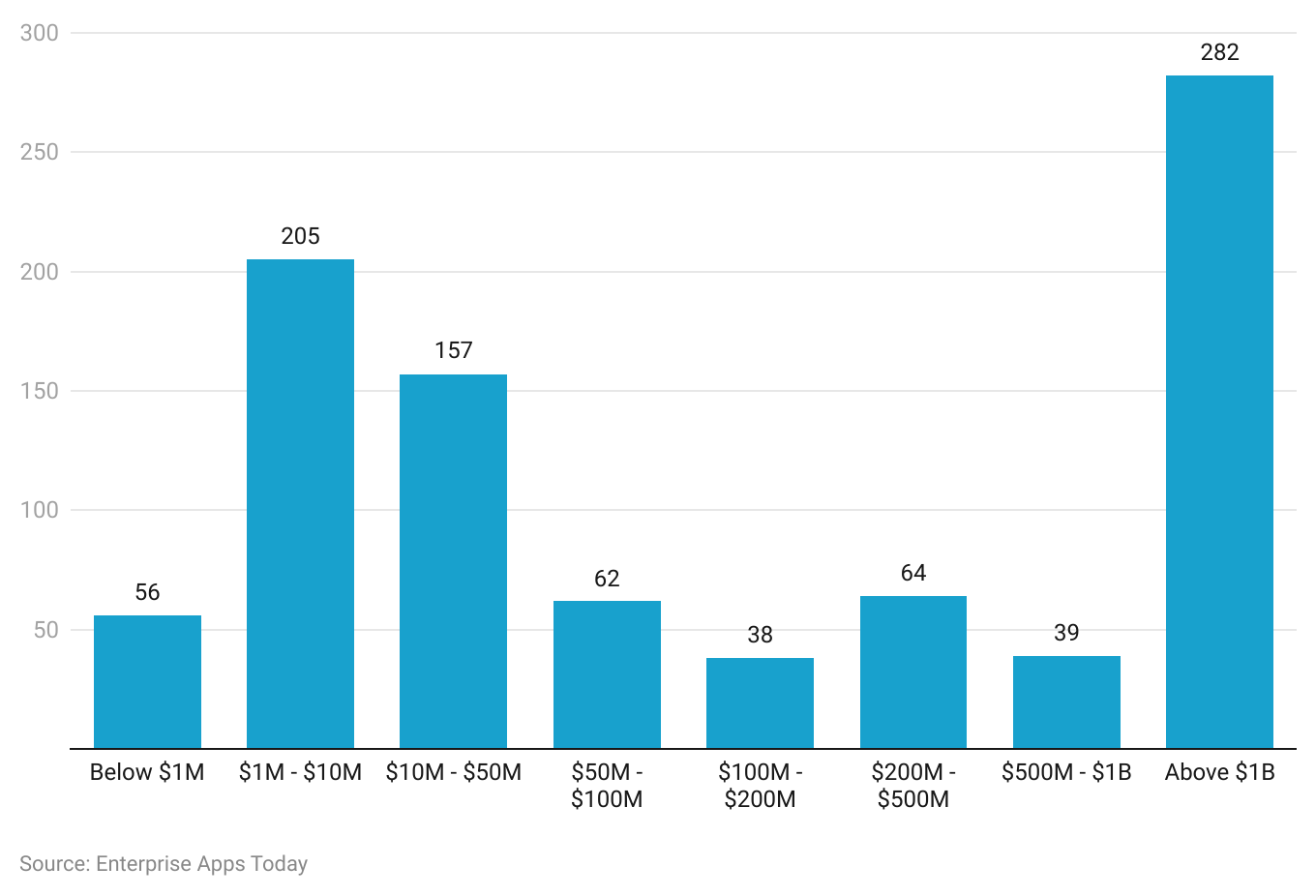 (Reference: HG Insights)
(Reference: HG Insights)
- As per the OpenAI statistics, there are 56 companies around the world whose revenue is below $1 million.
- Similarly, companies with a revenue between $1 million to $10 million are around 205 over the globe.
- 157 companies have revenue from $10 million to 50 million which are supporting the OpenAI platform.
- Companies with $50 million to $100 million in revenue are around 62 with OpenAI accommodated platforms.
- Moreover, other companies with the following revenues are supporting the OpenAI platform with their business processes $100 million to $200 million (38), $200 million to $500 million (64), $500 million to $1 billion (39) and companies with $1 billion and above (282).
- It has been observed that companies that have the highest revenue rate are accommodating the OpenAI platform on a larger scale than any other companies compared with the revenue ratios.
By Country
By Website Traffic
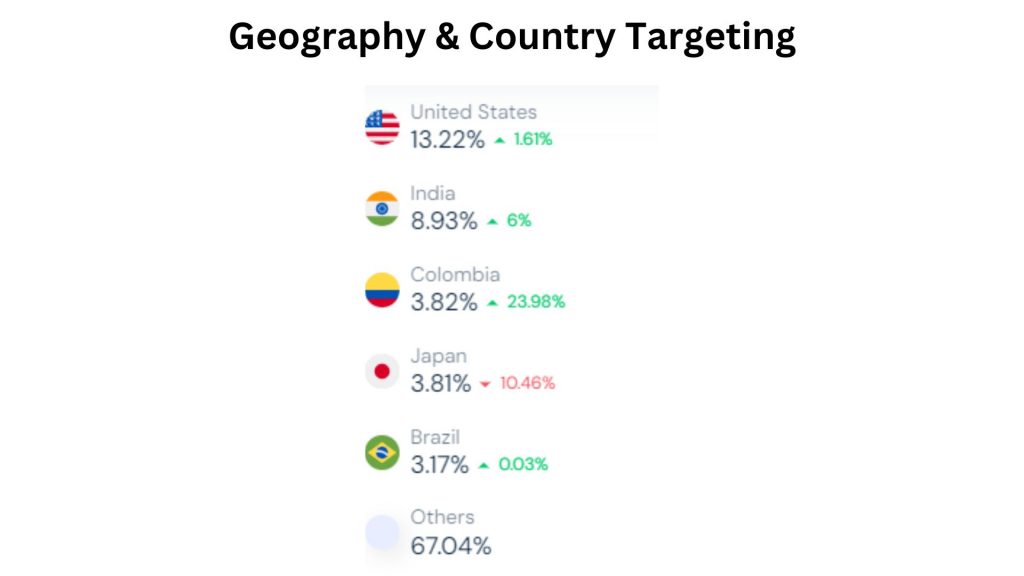 (Source: Similerweb)
(Source: Similerweb)
- In the last month, the United States of America had 13.22% of total traffic on openai.com, but it recorded an increase in total website visitors by 1.61%.
- India ranked second by contributing 8.93% of total traffic on openai.com which has increased by 6%.
- Other countries recorded the following contribution in total traffic Colombia (3.82%) increased by 2.98%, Japan (3.81%) decreased by 10.46%, and Brazil (3.17%) increased by 0.03%.
- Other countries with minor visitor rates collectively make up around 67.04%.
By Demographic
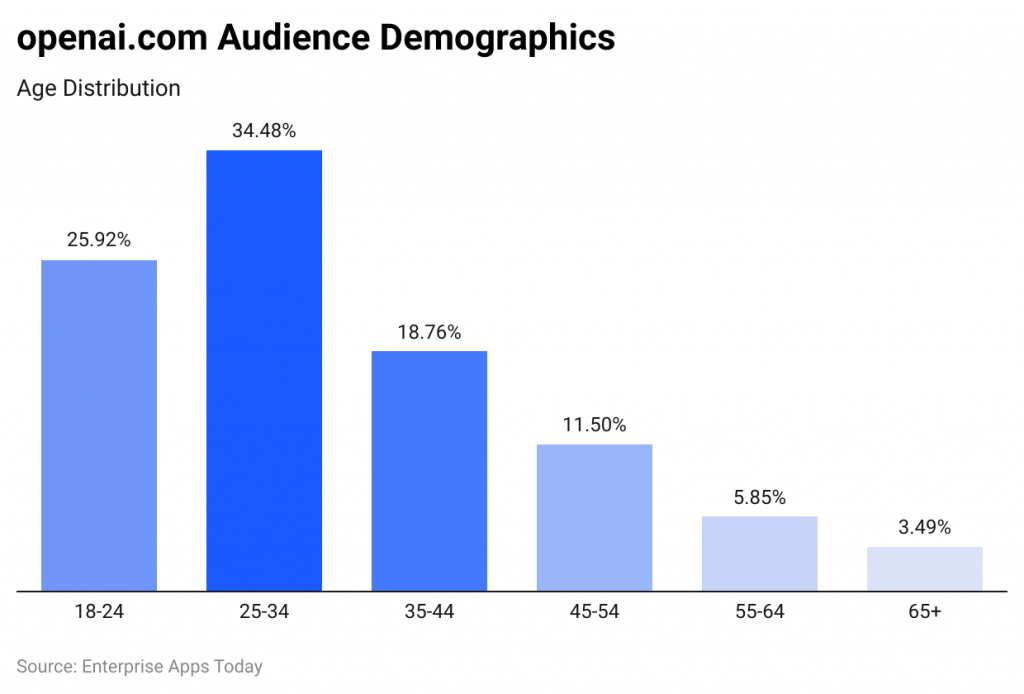 (Source: similarweb.com)
(Source: similarweb.com)
- OpenAI Statistics say that the platform has 42.38% female users and 57.62% of male users.
- The highest number of users is from the age group of 25 years to 34 years resulting in 34.48%.
- Similarly, there are 25.92% of users aged between 18 years to 24 years, and 18.76% of users are between 35 years to 44 years of age.
- 5% and 5.85% of users are from the age group of 45 years to 54 years and 55 years to 64 years respectively.
- Furthermore, there are 3.49% of users are 65 years and above.
By Traffic Source
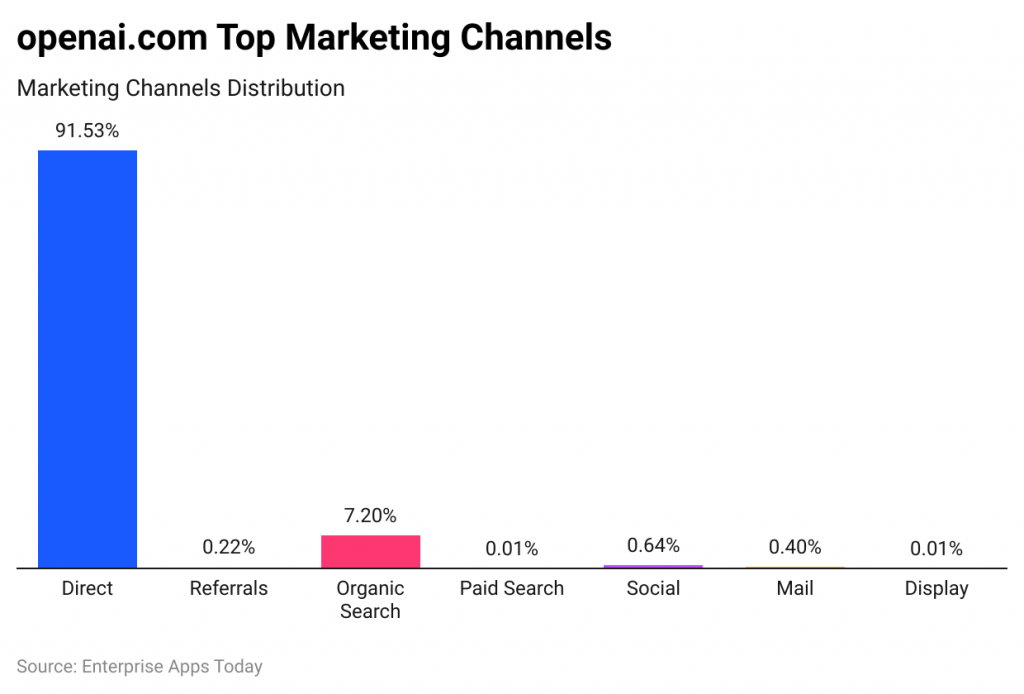 (Source: similarweb.com)
(Source: similarweb.com)
- As per the OpenAI statistics, the highest rate of traffic towards openai.com is by direct search resulting in 91.53%.
- Similarly, OpenAI statistics show that the website has 7.2% overall organic traffic, 0.22% referral traffic, and <0.01% paid search.
- There’s 0.64% overall social media traffic and 0.4% as well as 0.01% traffic is contributed by mail and display advertisements respectively.
By Referral Traffic
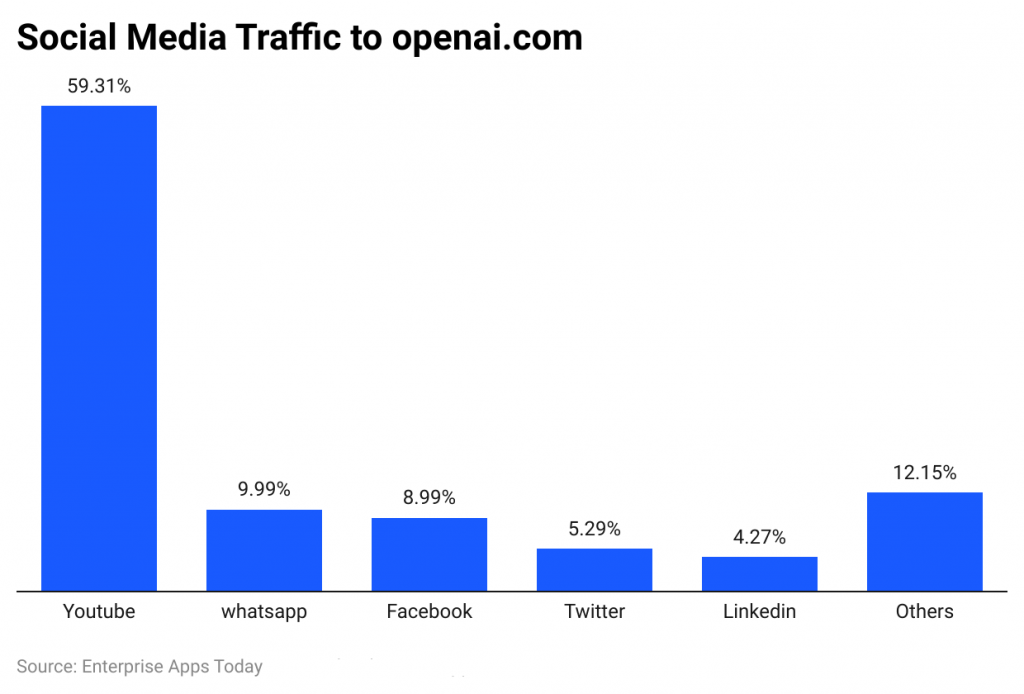 (Source: similarweb.com)
(Source: similarweb.com)
- According to OpenAI statistics, YouTube has the highest rate of referral to openai.com with 59.31%
- Similarly, as in the referral traffic, WhatsApp contributes 9.99% and 8.99% is contributed by Facebook.
- Twitter and LinkedIn have 5.29% and 4.27% referral rates respectively.
- Other social media networks of openai.com have an overall referral rate of 12.15%.
- Moreover, other websites also contribute to referral traffic such as programming and software developing websites (26.59%), directories and public record websites (22.19%), Emailers (7.39%), and random websites. (22.38%).
By ChatGPT Users
- ChatGPT stands for Chat Generative Pre-trained Transformer which is a language model-based chatbot developed by OpenAI.
- As of January 2023, ChatGPT has gained more than 100 million active users.
- In history, ChatGPT has been recorded to be the fastest-growing platform as within 60 days ChatGPT users have grown by 9,900%.
- In April 2023, ChatGPT there were around 173 million active users, in which the website visit of chat.openai.com has increased by 576.6%.
- The average time spent by each user is almost 8 minutes and 32 seconds.
OpenAI Employee Statistics
How Many Employees Does OpenAI Have in 2024?
As of 2024, OpenAI boasts a workforce of 624 employees. This marks a significant growth of approximately 70% from the year 2022, when the number stood at 335. This surge in workforce size is indicative of OpenAI's expanding operations and increasing influence in the artificial intelligence sector. The augmentation of staff not only supports a broadening scope of projects but also underscores OpenAI's commitment to advancing AI technology.
How Many Engineers Does OpenAI Employ in 2024?
In the year 2024, OpenAI employs over 475 engineers within its artificial intelligence department. This figure, while substantial, is notably smaller compared to the thousands of engineers that tech giants such as Google and Facebook dedicate to their AI initiatives. Nonetheless, the high concentration of engineers at OpenAI reflects the organization's deep focus on pioneering AI research and development, despite its relatively smaller size compared to these industry behemoths.
What is the Average Salary of an OpenAI Employee?
According to OpenAI statistics, the average annual salary for an OpenAI employee is $925,000. This exceptionally high salary is reflective of the competitive market for AI talent and OpenAI's position as a leading entity in the field.
OpenAI Revenue Statistics
What is OpenAI Valuation in 2024?
OpenAI's valuation in 2024 is estimated at $83 billion, approximately 17% of the total valuation and market share of the entire artificial intelligence industry of $500 billion.
How Much Money has Microsoft Invested in OpenAI?
Microsoft has invested a total of $11 billion in OpenAI, with $1 billion in 2019 and an additional $10 billion in 2023.
Is OpenAI Still a Non-Profit Organization?
OpenAI is no longer a non-profit organization. It transitioned from non-profit to “capped” for-profit in 2019, with the profit capped at 100 times any investment.
Where Does Most of OpenAI’s Profit Come From in 2024?
In 2024, most of OpenAI's profit comes from the platform’s partnerships and investments, with a smaller part of the revenue coming from selling subscriptions to ChatGPT+ ($20/mo).
What is the OpenAI’s Estimated Revenue in 2024?
As per OpenAI statistics; OpenAI’s estimated revenue in 2024 is $1 billion, largely attributed to ChatGPT+ subscriptions and new partnerships and investments. The revenue is predicted to grow 5x to reach this amount in 2024.
Conclusion
OpenAI statistics: After the pandemic, technology is rapidly changing connecting the world more closer.AI (artificial intelligence) technology is slowly replacing humans with their work. A few years ago, this technology was not available to everyone but as the pandemic caused more developments around the world, OpenAI-like technology became more accessible.
These kinds of technologies are finishing the work more speedily and with accuracy. The more surprising aspect of the OpenAI platform is it can help students by supporting their assignments. Today, the corporate world along with households and students is being benefited. Who knows one such technology can cook in the house without actual robots doing the household work?
Sources
FAQ.
The largest group of companies using OpenAI products consists of 214+ companies with more than 10,000 employees.
Following closely, the second largest group is comprised of companies with 1,000 to 5,000 employees, totaling 139+ companies using OpenAI products.
On the other hand, smaller companies with fewer employees seem to be more cautious in adopting OpenAI products. Only 45 companies with employee counts ranging from 500 to 999 have incorporated OpenAI products into their operations.
Surprisingly, there are 63 companies with fewer than 10 employees that have chosen to utilize the OpenAI platform.
In 2024, the top social media platforms that send the most traffic to OpenAI are:
- YouTube, which accounts for 55.47% of the traffic to OpenAI.
- WhatsApp, contributing 11.26% of the total traffic to OpenAI.
Additionally, other significant sources of traffic include:
- Facebook, with 9.47% of the traffic.
- Twitter, responsible for 5.66% of the traffic.
- LinkedIn, sending 3.87% of the traffic.

Barry is a lover of everything technology. Figuring out how the software works and creating content to shed more light on the value it offers users is his favorite pastime. When not evaluating apps or programs, he's busy trying out new healthy recipes, doing yoga, meditating, or taking nature walks with his little one.


